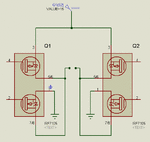JoKKeR
Full Member level 2
Hi!
I have low power DC motor. Full load at 15V is under 200mA.
Signals are coming from MCU.
Atm im liking 2x IRF7105. 1P and 1N type MOSFET array. ~0,5 EUR per part. The problem is that it is avalable only surface mount type.
IRF7105 datasheet: http://letsmakerobots.com/files/IRF7105.pdf

Probably i do not need drivers.
Thank you in advance!
I have low power DC motor. Full load at 15V is under 200mA.
Signals are coming from MCU.
Atm im liking 2x IRF7105. 1P and 1N type MOSFET array. ~0,5 EUR per part. The problem is that it is avalable only surface mount type.
IRF7105 datasheet: http://letsmakerobots.com/files/IRF7105.pdf

Probably i do not need drivers.
Thank you in advance!

